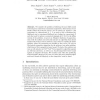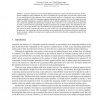83 search results - page 12 / 17 » Upper bounds on maximum likelihood for phylogenetic trees |
123
Voted
JCB
2000
15 years 18 days ago
2000
Multiple sequence alignments (MSAs) are frequently used in the study of families of protein sequences or DNA/RNA sequences. They are a fundamental tool for the understanding of th...
109
click to vote
ALT
2010
Springer
15 years 2 months ago
2010
Springer
We consider the problem of inferring the most likely social network given connectivity constraints imposed by observations of outbreaks within the network. Given a set of vertices ...
126
Voted
BMCBI
2008
15 years 28 days ago
2008
Background: The nucleotide substitution rate matrix is a key parameter of molecular evolution. Several methods for inferring this parameter have been proposed, with different math...
103
Voted
IWSEC
2010
Springer
14 years 11 months ago
2010
Springer
Abstract. Attack tree analysis is used to estimate different parameters of general security threats based on information available for atomic subthreats. We focus on estimating the...
101
click to vote
SPAA
1996
ACM
15 years 5 months ago
1996
ACM
We analyze the relationship between the expected packet delay in rooted tree networks and the distribution of time needed for a packet to cross an edge using convexity-based stoch...


